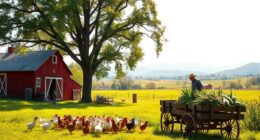Ranch branding traditions and family marks are powerful symbols of ownership, heritage, and community pride. You’ll see that brands are carefully designed to reflect family history, values, and regional identity, often passed down through generations. These marks are more than livestock identifiers—they represent loyalty, trust, and cultural legacy. Understanding these symbols helps you appreciate the deep roots and stories behind each ranch. Keep exploring to uncover more about this rich tradition.
Key Takeaways
- Ranch brands serve as family marks that identify ownership and preserve family heritage across generations.
- Traditional branding involves carefully designed symbols that reflect family history, values, and regional identity.
- Brands act as visual stories, linking ranches to land, ancestors, and cultural legacy.
- Many ranches maintain age-old branding practices to uphold cultural heritage and community loyalty.
- Branding traditions reinforce social bonds within ranching communities and symbolize trust and continuity.

Ranch branding traditions have long been a crucial part of ranch life, serving both practical and cultural purposes. When you think about branding, you might picture a mark burned into a cow’s hide, but it’s more than just a way to identify ownership. Branding history reveals that it was once used not only for identification but also as a symbol of loyalty and social status within ranching communities. Over time, the symbols and marks developed into a language of their own, with each ranch creating its unique brand to distinguish its livestock from others. These brands often carry symbolism significance, representing family heritage, regional identity, or specific ranch values. They serve as visual tokens that connect ranchers to their land and ancestors, reinforcing a sense of pride and continuity.
You might notice that each brand is carefully designed, often combining initials, geometric shapes, or symbolic elements that hold meaning for the ranch family. This symbolism significance isn’t arbitrary; it’s a deliberate expression of the ranch’s history, values, and identity. When you see a particular brand, you’re witnessing a story — a mark that tells you who owns the cattle and hints at the ranch’s origins or history. Many ranch families pass down their brands through generations, making them not just an identifier but a family mark that embodies legacy and tradition. This continuity strengthens bonds within the ranching community and preserves the cultural heritage associated with the practice.
Understanding the branding history and the symbolism significance adds depth to what might seem like a simple mark. It’s a visual language that communicates trust, ownership, and tradition. Ranchers invest time and thought into designing their brands, knowing they’re creating a lasting symbol that will be associated with their family and land for decades. Interestingly, the role of symbolism in branding echoes the importance of cultural heritage as a way to foster identity and community. Even as technology advances, many ranches still uphold these age-old practices, recognizing their importance in maintaining tradition and identity. The act of branding, therefore, isn’t just about marking livestock; it’s about preserving a cultural legacy that ties generations together through shared symbols and stories. As you appreciate this tradition, you gain insight into the profound connection between ranching practices and the cultural history that sustains them.
Frequently Asked Questions
How Do Ranchers Choose Their Brand Symbols?
You choose your brand symbols based on symbol selection that reflects your ranch’s identity and history. Cultural influences play a big role, guiding you to select symbols meaningful to your heritage or community. You might consider simple, recognizable shapes or initials that stand out. By blending tradition with personal or regional significance, you create a unique symbol that represents your ranch’s legacy and values.
Are There Legal Restrictions on Ranch Brands?
Yes, there are legal restrictions on ranch brands. You need to register your brand with the appropriate authorities to guarantee legal enforcement and protect your rights. This process helps prevent others from using similar marks, reducing disputes. By registering your branding, you gain official recognition, making it easier to defend your rights if someone infringes on your mark. Always follow local regulations to keep your branding legally protected.
How Has Branding Technology Evolved Over Time?
Branding technology has evolved considerably over time, incorporating branding innovations like electric branding irons and laser techniques that make marks clearer and less invasive. You’ve moved from traditional heated irons used in historical branding techniques to modern tools that improve efficiency and animal welfare. These advancements streamline the process, reduce injury, and produce more precise marks, helping you maintain tradition while embracing safer, more effective methods.
What Are Common Mistakes in Designing a Brand?
You should be aware of common branding misconceptions and design pitfalls when creating your brand. Many fall into mistakes like overcomplicating the logo, ignoring target audience preferences, or choosing trendy elements that won’t last. Avoid these pitfalls by focusing on simplicity, relevance, and consistency. Remember, a strong brand is clear, memorable, and authentic, so don’t rush the process or overlook fundamental principles that build lasting recognition.
How Do Brands Differ Across Regions?
Imagine you’re designing a brand and notice it resonates differently across regions. Regional variations and cultural influences shape how brands are perceived—colors, symbols, and messaging adapt to local values. For example, a logo appealing in Western states might not connect in Asia due to cultural differences. You must consider these regional nuances to guarantee your brand effectively communicates and builds trust in diverse markets.
Conclusion
Your family’s brand isn’t just a mark on cattle; it’s a story etched in iron and fire, a legacy that runs deep through generations. Embracing these traditions keeps your heritage alive, connecting you to the land and your ancestors like roots holding strong in the earth. As you pass down your mark, remember it’s more than a symbol—it’s the heartbeat of your family’s history, echoing through time like a timeless song that never fades.









